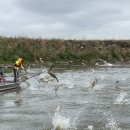Species that are considered high risk have a well-documented history of invasiveness in at least one location globally, and a high or medium climate match to the contiguous United States.
The Wakasagi (Hypomesus nipponensis) is a freshwater and brackish water fish native to eastern Russia, the Korean Peninsula, and areas of Japan. H. nipponensis supports both commercial and recreational fisheries. H. nipponensis has been introduced in California and now has multiple established populations. There are a few descriptions of negative impacts due to its introduction, including negatively impacted Kokanee Salmon. It has hybridized with the federally listed Delta Smelt (H. transpacificus). History of invasiveness is high. Certainty of assessment is medium due to most of the impact information coming from grey literature. This species has a high climate match with the contiguous United States. The majority of the country has a high to medium climate match. Only Louisiana, Mississippi, Nebraska, and Rhode Island have low individual climate scores. The overall risk for this species is high.



